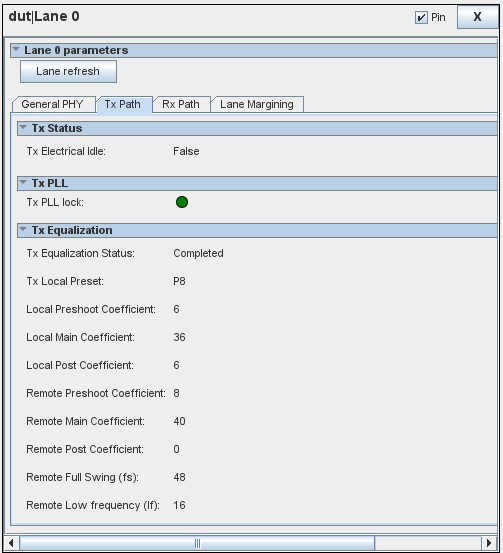Visible to Intel only — GUID: jhc1670278940769
Ixiasoft
1. About the R-Tile Avalon® Streaming Intel® FPGA IP for PCI Express
2. IP Architecture and Functional Description
3. Advanced Features
4. Interfaces
5. Parameters
6. Troubleshooting/Debugging
7. R-Tile Avalon® Streaming Intel® FPGA IP for PCI Express* User Guide Archives
8. Document Revision History for the R-Tile Avalon® Streaming Intel® FPGA IP for PCI Express* User Guide
A. Configuration Space Registers
B. Root Port Enumeration
C. Implementation of Address Translation Services (ATS) in Endpoint Mode
D. Packets Forwarded to the User Application in TL Bypass Mode
E. Margin Masks for the R-Tile Avalon Streaming Intel FPGA IP for PCI Express
3.2.2.5.1. VirtIO Common Configuration Capability Register (Address: 0x012)
3.2.2.5.2. VirtIO Common Configuration BAR Indicator Register (Address: 0x013)
3.2.2.5.3. VirtIO Common Configuration BAR Offset Register (Address: 0x014)
3.2.2.5.4. VirtIO Common Configuration Structure Length Register (Address 0x015)
3.2.2.5.5. VirtIO Notifications Capability Register (Address: 0x016)
3.2.2.5.6. VirtIO Notifications BAR Indicator Register (Address: 0x017)
3.2.2.5.7. VirtIO Notifications BAR Offset Register (Address: 0x018)
3.2.2.5.8. VirtIO Notifications Structure Length Register (Address: 0x019)
3.2.2.5.9. VirtIO Notifications Notify Off Multiplier Register (Address: 0x01A)
3.2.2.5.10. VirtIO ISR Status Capability Register (Address: 0x02F)
3.2.2.5.11. VirtIO ISR Status BAR Indicator Register (Address: 0x030)
3.2.2.5.12. VirtIO ISR Status BAR Offset Register (Address: 0x031)
3.2.2.5.13. VirtIO ISR Status Structure Length Register (Address: 0x032)
3.2.2.5.14. VirtIO Device Specific Capability Register (Address: 0x033)
3.2.2.5.15. VirtIO Device Specific BAR Indicator Register (Address: 0x034)
3.2.2.5.16. VirtIO Device Specific BAR Offset Register (Address 0x035)
3.2.2.5.17. VirtIO Device Specific Structure Length Register (Address: 0x036)
3.2.2.5.18. VirtIO PCI Configuration Access Capability Register (Address: 0x037)
3.2.2.5.19. VirtIO PCI Configuration Access BAR Indicator Register (Address: 0x038)
3.2.2.5.20. VirtIO PCI Configuration Access BAR Offset Register (Address: 0x039)
3.2.2.5.21. VirtIO PCI Configuration Access Structure Length Register (Address: 0x03A)
3.2.2.5.22. VirtIO PCI Configuration Access Data Register (Address: 0x03B)
4.3.1. Avalon® Streaming Interface
4.3.2. Precision Time Measurement (PTM) Interface (Endpoint Only)
4.3.3. Hot Plug Interface
4.3.4. Interrupt Interface
4.3.5. Hard IP Reconfiguration Interface
4.3.6. Error Interface
4.3.7. Completion Timeout Interface
4.3.8. Configuration Intercept Interface
4.3.9. Power Management Interface
4.3.10. Hard IP Status Interface
4.3.11. Page Request Services (PRS) Interface (Endpoint Only)
4.3.12. Function-Level Reset (FLR) Interface (Endpoint Only)
4.3.13. SR-IOV VF Error Flag Interface (Endpoint Only)
4.3.14. General Purpose VSEC Interface
5.2.3.1. Device Capabilities
5.2.3.2. VirtIO Parameters
5.2.3.3. Link Capabilities
5.2.3.4. Legacy Interrupt Pin Register
5.2.3.5. MSI Capabilities
5.2.3.6. MSI-X Capabilities
5.2.3.7. Slot Capabilities
5.2.3.8. Latency Tolerance Reporting (LTR)
5.2.3.9. Process Address Space ID (PASID)
5.2.3.10. Device Serial Number Capability
5.2.3.11. Page Request Service (PRS)
5.2.3.12. Access Control Service (ACS)
5.2.3.13. Power Management
5.2.3.14. Vendor Specific Extended Capability (VSEC) Registers
5.2.3.15. TLP Processing Hints (TPH)
5.2.3.16. Address Translation Services (ATS) Capabilities
5.2.3.17. Precision Time Measurement (PTM)
Visible to Intel only — GUID: jhc1670278940769
Ixiasoft
6.6.4.5.2. Tx Path
This tab allows you to monitor the transmitter settings for the channel selected.
| Group | Parameters | Values | Descriptions |
|---|---|---|---|
| Tx Status | Tx Electrical Idle | True False |
Indicates if TX is in electrical idle. True: indicates TX is in electrical idle. False: indicates TX is out of electrical idle. |
| Tx PLL Lock | Green Red |
Indicates if TX PLL is locked.
Note: The status of the Tx PLL Lock may not be reflected properly by the Debug Toolkit in the Quartus® Prime software version 22.4. The fix for this problem is planned for a future release of the Debug Toolkit.
|
|
| Tx Equalization | Tx Equalization Status | Not attempted Completed Unsuccessful |
Indicates transmitter equalization status. The TX local and remote parameters are valid only when the value of the Equalization status is returned as completed, indicating equalization has completed successfully. |
| Tx Local Preset | 0 - 10 | Indicates the R-Tile transmitter driver preset value as requested by the link partner during the Equalization phase of link training. If the preset is not one of these values, then no value is shown. | |
| Local Preshoot Coefficient | Depends on the coefficient requested by the link partner. | Indicates transmitter driver output pre-emphasis (pre-cursor coefficient value). | |
| Local Main Coefficient | Indicates transmitter driver output pre-emphasis (main cursor coefficient value). | ||
| Local Post Coefficient | Indicates transmitter driver output pre-emphasis (post-cursor coefficient value). | ||
| Remote Preshoot Coefficient | Depends on the transmitter driver output of the link partner. | Indicates link partner's transmitter driver's output pre-cursor coefficient value | |
| Remote Main Coefficient | Indicates link partner's transmitter driver's output main coefficient value | ||
| Remote Post Coefficient | Indicates link partner's transmitter driver's output post-cursor coefficient value | ||
| Remote Full Swing (fs) | Depends on the device capability of the link partner. | Indicates the full swing value used by the link partner during the Equalization phase of link training. | |
| Remote Low Frequency (lf) | Indicates the low frequency value used by the link partner during the Equalization phase of link training. |
Figure 73. Tx Path

